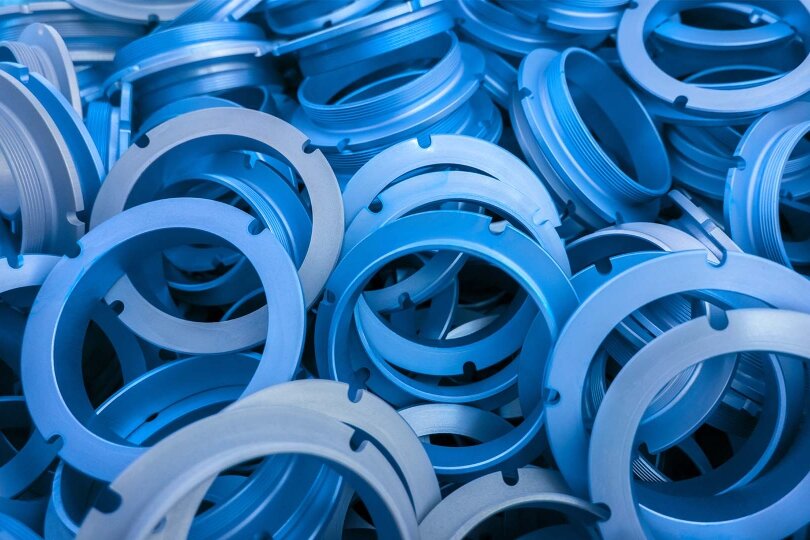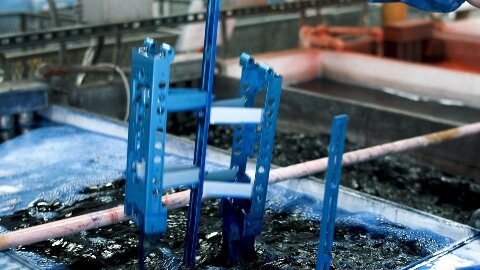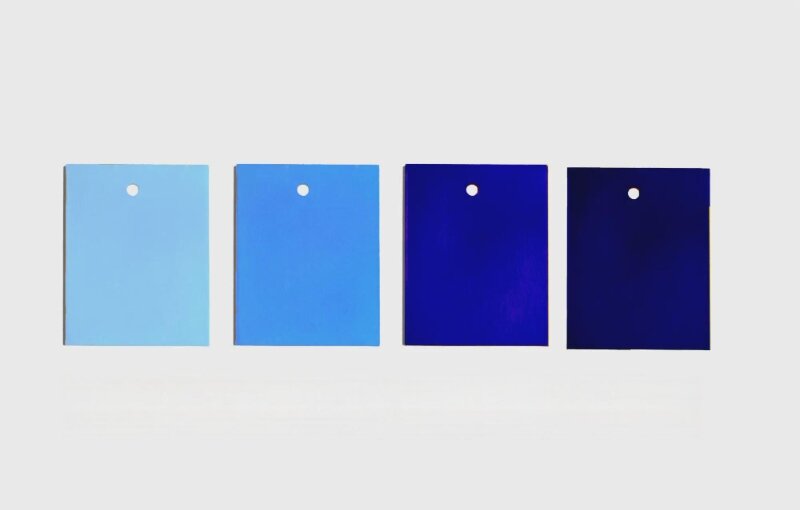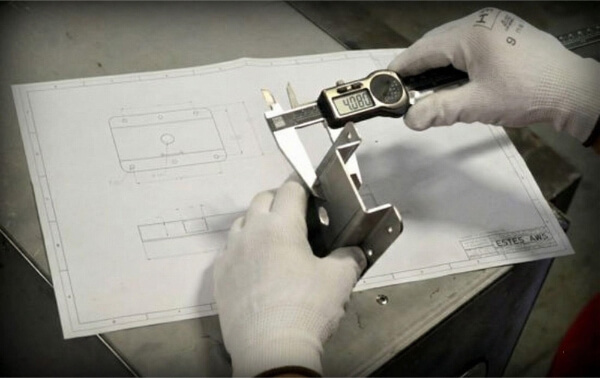Veel industrieën hebben metalen onderdelen nodig die opvallen, langer meegaan of bestand zijn tegen slijtage en corrosie. Misschien wil je metalen onderdelen met een blauwe afwerking voor het uiterlijk of om praktische redenen, maar weet je niet zeker hoe dit werkt. Het proces om die "geanodiseerd blauwe" kleur te creëren is op het eerste gezicht niet duidelijk en om de juiste keuze te maken, moet je de details kennen.
Wat maakt geanodiseerd blauw anders dan andere afwerkingen? Laten we eens kijken hoe het werkt, wat het te bieden heeft en waar het het beste past.

Wat betekent "geanodiseerd blauw"?
Blauw anodiseren verwijst naar aluminium of een ander metaal dat is geanodiseerd en vervolgens blauw is geverfd. Anodiseren is een elektrochemisch proces. Het verdikt de natuurlijke oxidelaag op het metaaloppervlak. Deze laag is hard, slijtvast en poreus.
Na het anodiseren kan het metaal kleurstoffen absorberen. Blauwe kleurstof wordt toegevoegd aan de poreuze laag en het metaal wordt dan verzegeld om de kleur in te sluiten. Het resultaat is een stevig, gekleurd oppervlak dat er goed uitziet en lang meegaat.
Blauw is een van de meest gevraagde kleuren voor geanodiseerde onderdelen. Het geeft een strakke, moderne uitstraling en veel technische merken, gereedschapsmakers en fabrikanten van medische apparatuur kiezen ervoor. Het is gemakkelijk te herkennen maar niet te opzichtig.
Blauw geanodiseerde onderdelen worden zowel voor het uiterlijk als voor de functie gebruikt. De kleur kan branding tonen, onderdeeltypes aangeven of helpen bij veiligheid en sorteren. Blauw is ook bestand tegen licht en hitte, waardoor het een solide keuze is in verschillende industrieën.
Het blauwe anodiseerproces voor aluminium
Anodiseren van aluminium bestaat uit verschillende stappen die elk bijdragen aan het creëren van een duurzaam, gekleurd oppervlak. Hier zie je hoe ruw aluminium een levendig, blauw afgewerkt onderdeel wordt.
Het oppervlak reinigen en voorbereiden
Eerst moet het aluminium gereinigd worden. Oliën, vuil en oxiden worden verwijderd met alkalische of zure reinigingsmiddelen. Een schoon oppervlak is essentieel. Achtergebleven resten kunnen de afwerking ruïneren.
Vervolgens kan het onderdeel geëtst worden. Deze stap maakt het oppervlak glad en verwijdert kleine krasjes. Daarna wordt het gespoeld in gedeïoniseerd water om chemicaliën te verwijderen voordat het anodiseren begint.
Elektrochemische oxidevorming
Het gereinigde aluminium wordt in een zuurbad geplaatst. Vervolgens wordt er een elektrische stroom op gezet. Het aluminium wordt de anode, terwijl een kathode (vaak lood of roestvrij staal) het circuit voltooit.
Terwijl de stroom vloeit, komt er zuurstof vrij. Deze reageert met het aluminium om een oxidelaag te vormen. Deze laag is poreus en veel complexer dan ruw aluminium. De dikte is afhankelijk van de spanning, de tijd en de temperatuur.
Kleuren met kleurstof of elektrolyt
Nadat de oxide is gevormd, is het onderdeel klaar om gekleurd te worden. Er zijn twee manieren om het blauw toe te voegen:
- Verfmethode: Het onderdeel wordt in een blauw verfbad gedompeld, waar de kleurstof in de poreuze oxidelaag trekt. Dit is de meest gebruikte manier om geanodiseerd blauw te maken.
- Elektrolytisch kleuren: Deze methode gebruikt metaalzouten en stroom om kleur te creëren. Het is minder gebruikelijk voor blauw en vaker voor bronzen of zwarte afwerkingen.
De verfmethode geeft heldere, consistente kleuren en meer mogelijkheden om de kleur te regelen.
De oxidelaag afdichten
Als laatste volgt het sealen. Het onderdeel wordt in kokend water of een nikkelacetaatoplossing gelegd. Dit sluit de poriën in de oxidelaag en sluit de kleurstof in.
Verzegelen verbetert de corrosiebestendigheid en voorkomt dat de kleur vervaagt. Het oppervlak voelt ook gladder aan. Na het sealen is het onderdeel klaar voor gebruik.

Hoe wordt de blauwe kleur bereikt bij het anodiseren?
Het creëren van een blauw geanodiseerde afwerking hangt af van de manier waarop de kleur in de oxidelaag wordt gebracht. Er worden twee primaire methoden gebruikt en verschillende factoren bepalen het uiteindelijke resultaat.
Gebruik van organische kleurstoffen
De meest gebruikelijke manier om geanodiseerd blauw te maken is door organische kleurstoffen te gebruiken. Na het anodiseren is de poreuze oxidelaag klaar om kleurstof te absorberen. Het onderdeel wordt in een verfbad gedompeld dat gevuld is met blauw pigment. De kleurstof vult de poriën en hecht zich aan het oppervlak.
Verschillende verfsoorten en onderdompeltijden veranderen de diepte en tint van het blauw. Sommige kleurstoffen geven een diepe marineblauwe kleur, terwijl andere lichter of helderder blauw produceren.
Gebruik van elektrolytische kleuring
Elektrolytisch kleuren maakt gebruik van een tweede elektrisch proces na anodiseren. Metaalzouten, zoals tin of kobalt, worden in de poriën gebracht met behulp van een elektrische stroom. Deze methode geeft kleur door metaalafzetting in plaats van kleurstoffen.
Elektrolytische kleuring wordt vaak gebruikt voor brons, zwart of afwerkingen omdat het moeilijker is om blauwe tinten te krijgen. Toch kunnen sommige systemen op deze manier een donkerblauwe tint produceren.
Factoren die schaduw en uniformiteit beïnvloeden
Verschillende dingen beïnvloeden de uiteindelijke kleur:
- Oxidedikte: Dikkere lagen absorberen meer kleurstof, waardoor de kleur donkerder wordt.
- Type en kwaliteit kleurstof: Verschillende kleurstoffen geven verschillende tinten en lichtechtheid.
- Tijd in verfbad: Langer onderdompelen verdiept de kleur.
- Temperatuur: Zowel de kleurstof- als de sealtemperatuur hebben invloed op het eindresultaat.
- Materiaal legering: Verschillende soorten aluminium reageren verschillend tijdens het anodiseren.
- Oppervlaktevoorbereiding: Een ruw oppervlak absorbeert kleurstof ongelijkmatig, wat leidt tot vlekkerige kleuren.
Soorten geanodiseerde blauwe afwerkingen
Blauw geanodiseerde onderdelen kunnen er op verschillende manieren uitzien. De uiteindelijke afwerking hangt af van hoe het aluminium is voorbereid en behandeld voor het anodiseren. Hier zijn de meest voorkomende afwerkingen.
Helder geanodiseerd blauw
Deze afwerking heeft een gladde, natuurlijke metaallook met een lichtblauwe tint. Het aluminium is meestal gepolijst of geborsteld voor het anodiseren, geverfd en verzegeld. De textuur van het metaal is voornamelijk zichtbaar onder de kleur.
Dit type is populair vanwege de kleur en het schone, metaalachtige gevoel. Het wordt vaak aangetroffen in elektronica, gereedschap of consumentenproducten.
Mat geanodiseerd blauw
Matte afwerkingen worden gemaakt door etsen of zandstralen het oppervlak voor het anodiseren. Dit verwijdert glans en zorgt voor een zachte, vlakke look. Daarna wordt het onderdeel geanodiseerd en blauw geverfd.
Matblauw geanodiseerde onderdelen reflecteren geen licht, waardoor ze handig zijn in situaties waar verblinding een probleem is, zoals bij outdooruitrusting, verlichting of medisch gereedschap.
Glanzend Geanodiseerd Blauw
Glanzende afwerkingen komen van het polijsten van het aluminium tot een spiegelachtig oppervlak voor het anodiseren. Het gladde oppervlak reflecteert meer licht, zelfs na het verven en sealen.
Deze afwerking wordt vaak gekozen voor decoratieve onderdelen of producten waarbij het uiterlijk het belangrijkst is. Het geeft een helder, opvallend blauw met een high-end uitstraling.

Eigenschappen van geanodiseerde blauwe oppervlakken
Geanodiseerde blauwe oppervlakken zien er niet alleen goed uit. Ze bieden belangrijke prestatievoordelen waardoor ze nuttig zijn in vele industrieën. Hieronder staan de belangrijkste eigenschappen die hun waarde bepalen.
Corrosiebestendigheid
Anodiseren voegt een dikke, stabiele oxidelaag toe die het metaal eronder beschermt. Deze laag zorgt ervoor dat vocht, lucht en chemicaliën het metaaloppervlak niet kunnen bereiken, waardoor corrosie wordt vertraagd, zelfs in zoutnevel of vochtige omgevingen.
Bij de juiste afdichting is de geanodiseerde laag bestand tegen roest en putjes, waardoor het een goede keuze is voor buiten, op zee en in de industrie.
Oppervlaktehardheid en duurzaamheid
De geanodiseerde laag is veel harder dan onbehandeld aluminium. Het is bestand tegen krassen, slijtage en schuren tijdens dagelijks gebruik, waardoor een geanodiseerde blauwe afwerking nuttig is voor onderdelen die worden gehanteerd, verplaatst of blootgesteld aan wrijving.
Het oppervlak is ook bestand tegen afschilferen of afbladderen omdat de oxidelaag van binnenuit het metaal groeit en niet alleen aan de bovenkant.
UV- en kleurbestendigheid
Kwaliteitsblauwe kleurstoffen voor anodiseren kunnen zonlicht aan. Met een goede verzegeling houdt de kleur goed stand bij blootstelling aan UV. Dit is belangrijk voor buitenonderdelen of producten die lang in direct licht staan.
Goedkopere kleurstoffen kunnen sneller vervagen. Daarom is het essentieel om UV-stabiele kleurstoffen te gebruiken en het oppervlak goed af te dichten.
Visueel aantrekkelijk en reflecterend
Geanodiseerd blauw heeft een strakke, moderne uitstraling die veel industrieën mooi vinden. Het kan variëren van zacht en mat tot helder en glanzend. De afwerking benadrukt de textuur van het metaal, waardoor elk onderdeel uniek is.
Het reflecteert ook licht, wat diepte en rijkdom aan de kleur toevoegt. Dit maakt het nuttig in branding, productontwerp en consumentenelektronica.
Voordelen van geanodiseerde blauwe afwerkingen
Geanodiseerde blauwe oppervlakken zijn niet voor niets zo populair. Ze combineren uiterlijk, functie en duurzaamheid. Hieronder staan enkele duidelijke voordelen die ze tot een solide keuze maken.
Esthetische flexibiliteit
Blauw geanodiseerd geeft een gedurfde maar professionele look. Het proces maakt vele stijlen mogelijk en je kunt de tint, afwerking en helderheid zelf bepalen. Of je nu zacht mat of hoogglanzend wilt, het proces biedt veel mogelijkheden.
Deze flexibiliteit maakt het gemakkelijk om merkkleuren te matchen, visueel contrast te creëren of onderdeeltypes in assemblages te signaleren. Het werkt ook goed in zowel industriële als consumentenproducten.
Prestaties op lange termijn
De geanodiseerde laag bladdert of schilfert niet. Hij is bestand tegen slijtage, krassen en weersinvloeden. Met een goede verzegeling blijft de kleur jarenlang levendig.
In tegenstelling tot verven of plateren hecht anodiseren zich aan het metaal. Dat betekent minder retouches en minder risico op beschadiging tijdens verwerking of verzending.
Milieuvriendelijk
Anodiseren is een van de schonere oppervlaktebehandelingen. Er worden geen zware metalen of giftige coatings gebruikt. De belangrijkste chemicaliën zijn herbruikbaar en afval is gemakkelijker te beheren.
Het proces versterkt ook het basismetaal, waardoor vervanging of reparatie minder vaak nodig is. Dit verlaagt het materiaalgebruik en ondersteunt een langere levensduur van het product.
Vergelijking met andere afwerkingen
Het kiezen van de juiste afwerking hangt af van de eigenschappen van je product. Hier zie je hoe blauw zich verhoudt tot andere standaard afwerkingsopties voor aluminium onderdelen.
| Categorie | Blauw geanodiseerd | Blauw geschilderd | Blauw poedercoating | Natuurlijk geanodiseerd |
|---|---|---|---|---|
| Type | Elektrochemische coating | Vloeibare coating | Elektrostatische poedercoating | Elektrochemische coating |
| Uiterlijk | Metallic blauw, mat tot glanzend | Diverse blauwe tinten, glanzend of mat | Gladde, uniforme blauwe afwerking | Zilvergrijs metallic |
| Duurzaamheid | Hoog | Laag tot gemiddeld | Gemiddeld tot hoog | Hoog |
| Corrosiebestendigheid | Hoog | Medium | Hoog | Hoog |
| Kleurstabiliteit | Uitstekend | Slecht tot Redelijk | Goed | Uitstekend |
| Onderhoud | Laag | Hoog | Medium | Laag |
| Oppervlaktestructuur | Zichtbare aluminium textuur | Verborgen onder verflaag | Glad en dikker oppervlak | Zichtbare aluminium textuur |
Algemene toepassingen van geanodiseerd blauw
Blauw geanodiseerd wordt in veel industrieën gebruikt. Het biedt duurzaamheid, een strak uiterlijk en een sterke weerstand tegen corrosie. Hier zijn enkele van de meest voorkomende toepassingen.
Consumentenelektronica
Laptops, smartphones en audioapparatuur gebruiken vaak onderdelen van geanodiseerd blauw aluminium. De afwerking geeft een strakke, moderne look terwijl het oppervlak beschermd wordt tegen krassen en vingerafdrukken.
Merken gebruiken de kleur ook om op te vallen of om bij hun ontwerpthema's te passen. Anodiseren houdt de kleur stabiel zonder de werking van het toestel te beïnvloeden.
Architecturale elementen
Deuren, raamkozijnen, panelen en leuningen worden soms afgewerkt in geanodiseerd blauw. De kleur voegt een visueel accent toe aan gebouwen en beschermt het metaal tegen zon, regen en vervuiling.
Het oppervlak houdt goed stand buiten en heeft weinig onderhoud nodig, waardoor het een slimme keuze is voor langdurig gebruik.
Automotive
Aangepaste onderdelen zoals versnellingspookknoppen, sierstukken, pedalen en motordeksels worden blauw geanodiseerd voor zowel het uiterlijk als de bescherming. De afwerking valt op, is hittebestendig en slijtvast.
Het wordt ook gebruikt in race- en motoronderdelen voor gewichtsbesparing en stijl.
Ruimtevaart
In interieurs en structurele onderdelen van vliegtuigen kan geanodiseerd blauw worden gebruikt om gewicht te verminderen, corrosie te voorkomen en de tracking van onderdelen te verbeteren. De kleur helpt bij het identificeren van verschillende onderdeeltypes en voegt duurzaamheid toe zonder bulk toe te voegen.
De luchtvaartindustrie waardeert anodiseren vanwege de betrouwbare prestaties in extreme omstandigheden.
Conclusie
Blauw geanodiseerd is een duurzame en aantrekkelijke afwerking die ontstaat door een elektrochemisch proces. Het verbetert de corrosiebestendigheid, oppervlaktehardheid en visuele aantrekkingskracht. De blauwe kleur wordt toegevoegd met kleurstoffen of elektrolytische methodes en wordt verzegeld om de prestaties te behouden. Het wordt gebruikt in elektronica, medisch gereedschap, auto-onderdelen en architectuur.
Op zoek naar blauw geanodiseerde onderdelen met betrouwbare prestaties en een schone afwerking? Neem vandaag nog contact met ons op voor een gratis offerte en deskundige ondersteuning.
Hey, ik ben Kevin Lee

De afgelopen 10 jaar heb ik me verdiept in verschillende vormen van plaatbewerking en ik deel hier de coole inzichten die ik heb opgedaan in verschillende werkplaatsen.
Neem contact op

Kevin Lee
Ik heb meer dan tien jaar professionele ervaring in plaatbewerking, gespecialiseerd in lasersnijden, buigen, lassen en oppervlaktebehandelingstechnieken. Als technisch directeur bij Shengen zet ik me in om complexe productie-uitdagingen op te lossen en innovatie en kwaliteit in elk project te stimuleren.




